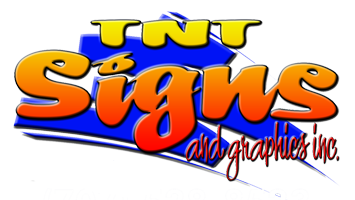Color has an incredible power to influence our emotions, perceptions, and even decision-making processes. In the world of business signage, choosing the right color is far more than an aesthetic choice; it’s a critical element that can significantly impact how customers perceive your brand and, ultimately, whether they decide to engage with your business. At TNT Signs, we understand the importance of color psychology in creating custom signs that don’t just look good but also resonate with your target audience. In this blog, we’ll dive into the fascinating world of color psychology and how it plays a pivotal role in signage that captures attention, communicates messages effectively, and drives customer engagement.
Why Color Choice Matters in Business Signage
When potential customers see a business sign, their brains process the colors before they even register the words. Studies have shown that color increases brand recognition by up to 80% and can have a dramatic effect on the perception of a brand’s credibility, trustworthiness, and appeal. Choosing the right colors for your signage is essential to creating the emotional response you want from your audience and establishing a strong, memorable brand presence.
Imagine a daycare using dark, muted colors versus bright, playful ones. The color choice alone can dramatically change how people feel about the business. The same principle applies to all types of businesses, from restaurants and retail shops to banks and medical offices. Let’s take a look at the meanings and associations of different colors and how they can enhance business signage.
Color Meanings and Associations
1. Red: Energy, Urgency, and Passion
Red is a powerful color that grabs attention and stimulates excitement. It’s often associated with urgency, passion, and energy. In business signage, red is commonly used in industries that want to create a sense of excitement or urgency, such as fast-food restaurants, which rely on red to stimulate appetite and prompt quick decisions.
When to Use Red:
- To draw attention and evoke a sense of urgency, making it ideal for sales promotions.
- For businesses that want to convey energy, action, or excitement.
- To create a memorable impact, especially in competitive spaces where you want to stand out.
2. Blue: Trust, Calmness, and Reliability
Blue is one of the most universally liked colors and is often associated with trust, calmness, and stability. It’s commonly used by financial institutions, healthcare providers, and technology companies—industries where trust and reliability are paramount.
When to Use Blue:
- For businesses that want to instill a sense of dependability and security, such as banks, insurance agencies, and consulting firms.
- In medical or health-focused signage to convey calmness and professionalism.
- For tech companies aiming to appear trustworthy and forward-thinking.
3. Green: Health, Growth, and Sustainability
Green is synonymous with nature, health, and growth. It’s often chosen by eco-friendly brands, wellness companies, and outdoor recreation businesses. Green can give customers a feeling of renewal, safety, and positivity, making it particularly effective for businesses with environmental values.
When to Use Green:
- For brands that want to emphasize their commitment to sustainability or health, like organic grocery stores or health spas.
- In outdoor or adventure-focused businesses that want to connect with nature.
- For financial services aiming to convey growth, prosperity, and success.
4. Yellow: Cheerfulness and Positivity
Yellow is a bright, energetic color that conveys happiness, friendliness, and positivity. This color naturally attracts attention and is often used in signage to evoke feelings of warmth and cheerfulness. It’s ideal for family-friendly businesses, casual dining, and services that aim to make customers feel happy and welcome.
When to Use Yellow:
- For businesses that want to create a welcoming, upbeat environment, such as toy stores or casual eateries.
- To make the sign pop and attract attention from a distance.
- For businesses that focus on fun, creativity, and positivity.
5. Black: Sophistication and Elegance
Black is a timeless color that conveys sophistication, luxury, and strength. It’s often used by high-end brands, including luxury retailers, upscale restaurants, and professional services like law firms. When combined with metallic accents or other sleek colors, black can give a sign a refined, premium feel.
When to Use Black:
- For luxury or high-end businesses looking to project exclusivity and quality.
- When paired with minimalist design to create a bold, modern look.
- For professional services that want to project authority and reliability.
6. White: Simplicity and Cleanliness
White is often associated with purity, cleanliness, and simplicity. It’s commonly used in healthcare and wellness industries, as well as brands that want a modern, minimalist look. White can help a sign appear more open and welcoming, providing a balanced backdrop that allows other colors or text to stand out.
When to Use White:
- For medical facilities, spas, or wellness brands that want to project cleanliness and tranquility.
- As a background color to make other colors or fonts stand out.
- For modern, minimalist designs that aim to convey simplicity and openness.
Matching Color with Brand Personality
At TNT Signs, we believe that choosing colors for your business sign should be a reflection of your brand personality. Colors play a crucial role in communicating the values, mission, and goals of your business. For example, a fun and energetic cafe might use warm colors like red or orange, while a sophisticated law firm might opt for cooler colors like navy blue or black.
Here’s how TNT Signs helps businesses choose colors that align with their brand identity:
- Understand Your Brand Values: Are you a fun, youthful brand or a sophisticated, traditional one? Your colors should align with your brand’s core personality.
- Know Your Audience: Think about the demographics and preferences of your target audience. Younger customers may respond better to bright, bold colors, while older demographics may prefer muted, classic tones.
- Consider the Environment: Where will the sign be located? In high-traffic areas, brighter colors may be more effective, while quieter settings may call for subtler tones.
Examples of Effective Color Use in Signage
Many successful brands have leveraged color to enhance their business signage. Here are a few examples:
- McDonald’s: The brand uses red and yellow, colors that encourage appetite and happiness. Red is attention-grabbing, while yellow is associated with positivity and friendliness.
- Starbucks: The green in Starbucks signage reflects growth, nature, and relaxation, aligning with the brand’s commitment to sustainability and providing a cozy atmosphere.
- FedEx: FedEx uses a mix of purple and orange, representing creativity, reliability, and excitement, which reflects their fast-paced and trustworthy delivery service.
Tips for Creating Balanced, Eye-Catching Color Schemes
While color can make a strong impact, it’s essential to use it wisely to avoid overwhelming or confusing your audience. Here are some tips for creating balanced color schemes that attract attention and maintain a professional look:
- Limit the Number of Colors: Too many colors can be distracting. Limit your palette to two or three main colors for a balanced, cohesive look.
- Choose Complementary Colors: Use a color wheel to find complementary colors that work well together, such as blue and orange or red and green.
- Consider Contrast: Ensure there’s enough contrast between the background and text colors. High contrast makes the text readable from a distance, especially for outdoor signage.
- Test Before Finalizing: Make sure the colors look good together in various lighting conditions, both day and night.
How TNT Signs Helps Bring Color Psychology into Signage
At TNT Signs, we work closely with our clients to understand their brand identity, target audience, and goals. By incorporating color psychology into our design process, we create signage that not only looks great but also resonates with the intended audience.
Our Process:
- Consultation: We start by discussing your brand personality, goals, and audience. This helps us choose colors that align with your vision.
- Design Phase: Our designers create mock-ups with color options that reflect your brand and stand out in your environment.
- Feedback and Finalization: You’ll have the opportunity to provide feedback on the color choices, ensuring that the final design meets your expectations.
Conclusion
Choosing the right colors for your business signage can make a powerful impact on customer perceptions, enhancing brand awareness and driving engagement. By understanding the psychology of color, businesses can create signs that go beyond aesthetics to connect with customers on an emotional level.
At TNT Signs, we specialize in helping businesses choose colors and designs that reflect their brand identity and resonate with their target audience. Contact us today to learn how we can help create custom signage that not only catches the eye but also leaves a lasting impression. Whether you’re looking for a bold, colorful design or a subtle, sophisticated look, we’re here to help bring your brand to life through the power of color.









